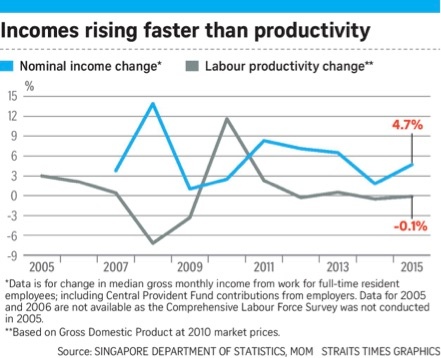As a business, you would need to be highly productive to succeed in a competitive environment in Singapore. Time is money and the less time spent on a task means you can more work with less employees. The business makes more money and every employee gets paid more. This would be a win-win situation and everyone is happy.
The actual situation is slightly different. Currently, income is increasing faster than business productivity which is a source of worry for both sides.
Source: The Straits Times
Questions such as whether such increments are sustainable begin to weigh on both the employers and employee. For over 30 years, the Singapore Government has been encouraging companies to improve their productivity. In this article, we will introduce some innovative productivity tools that emerged recently. Perhaps your business can consider using them?
1) Virtual Design and Construction - VR full dress rehearsal cuts rework
The construction industry is notorious for its over-dependence on cheap labour and low productivity growth. Productivity actually declined by 1.1% in 2016 compared to 2015. The slow growth coupled with the tightening of construction worker supply means the construction industry are under pressure to improve their productivity.
Source: Ministry of Manpower
One of the most exciting recent virtual reality (VR) technology would be Virtual Design and Construction (VDC). Instead of a staid blueprint, VDC provides a full dress rehearsal for architects, engineers, construction managers, owners, regulators and other stakeholders to provide inputs before the project is constructed.
Source: Mortenson
Instead of having to fiddle with stacks of papers, such designs can be seen from different angles on your tablets on 3D. Such models can be drawn to precision down to the last 10 centimetres and you can see how sunlight and other elements affect your building.
VDC has been used in Singapore to construct the mega projects such as Changi General Hospital Medical Centre and Northpoint City. VDC allows all parties to be on same page and it reduces rework and mistakes. According to a construction company, VDC allowed them to reduce rework by 50% to 90% and increased their productivity by 4% to 28%.
Higher productivity also means lower building costs. Property owners would spend less time on construction and this will reduce their labor and business financing cost. All these would lead to more affordable office spaces in Singapore.
So how expensive is a VDC? Well it depends your choice. Sketchup Pro cost US$695 per edition while the more established AutoCAD Revit will cost you US$2,038.35/year. This is affordable to you even if you are small architect firm and you can even tap on the $450 million Construction Productivity and Capability Fund (CPCF) by the Building and Construction Authority (BCA) which had benefited 9,000 firms and 90% of them are SMEs. You can defray up to 70% of the cost or up to $30,000 so even the expensive AutoCAD software will cost just US$611.50 per year (S$838/year) and the cheaper Sketchup would cost US$208.50 (S$286).
2) Chef Watson - Create new recipes in minutes with Artificial Intelligence
If you are a restaurant owner, one of the main challenge would be to have new recipes to entice your clients to come back for more. There are literally thousands of restaurants out there who wants to get the next Michelin star and owners dream of having long queues from their doors. Having good food is more important than having flying robots as waiters but creating new recipe to lure in the clients is tedious.
There are 7 steps to take to create a proper new food recipe from developing an ingredient list, visualizing, sketching to tasting. It takes an expert dish designer 80 to 90 hours to create a new dish and their services don’t come cheap. What if I say you can create a new dish in 5 minutes with improved concentration?
Source: IBM Chef Watson
The 5 minutes is only needed for you to choose what type of style or occasion that new dish is for and to select the right recipe. Otherwise you can also create a new dish from your favourite ingredient. Chef Watson powered by artificial intelligence that can suggest thousand of dishes within seconds as you choose them. It is powered by the same technology that allows computers to beat chess experts at their own game. The best part of this machine is that it is absolutely free.
3) Telepresence robots - improve work-life balance & revenue
There will be times where you can’t be in the office. For instance, you might be on a business trip overseas when your colleagues needs to consult you on some detailed work. While you can talk over Skype but it is easier when you have a tele presence robot that allows you to see your screen and other co-workers involved in the discussion.
Source: MacWorld
Such telepresence robots are also used in Singapore by 3E Accounting. According to a TodayOnline interview with their CEO Mr Lawrence Chai, telepresence robots increased their productivity and facilitated their family friendly culture with flexible work arrangement. Average revenue per employee increased from $92,037 to $135,076 per year and productivity improved from 41.96% to 46.76%. It is also useful for them in retaining their employees.
The TodayOnline report mentioned that this robot cost $7,000 and it is claimable under the Productivity and Innovation Credit (PIC) scheme. IRAS website shows that up to $100,000 or 40% is claimable in cash, reduced from the 70% of previous years, and this means that it would cost $4,200 to bring in this robot today. This is a small price to pay for the productivity improvement and within the reach of most SMEs.
Competitive Edge
I hope that these three unconventional methods of improving productivity would be useful in your companies’ drive to prosper in Singapore. Higher productivity is a competitive edge for companies to stand out in a crowded field regardless of whether you are a start-up or a SME. These ideas might not be exactly suited for your particular case but it should give you an idea of the possibilities out there. Good luck!
Learn more about how a Business Growth Assessment can help unlock your business' potential, and register below for your free assessment.







